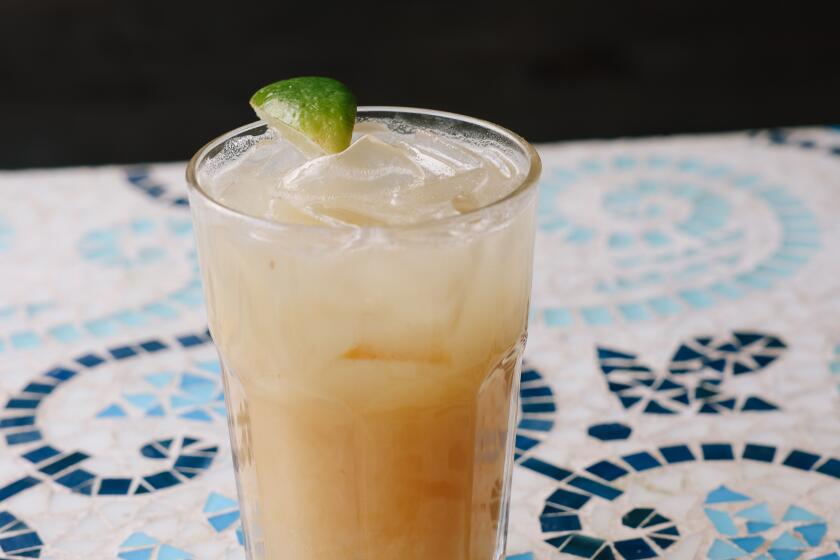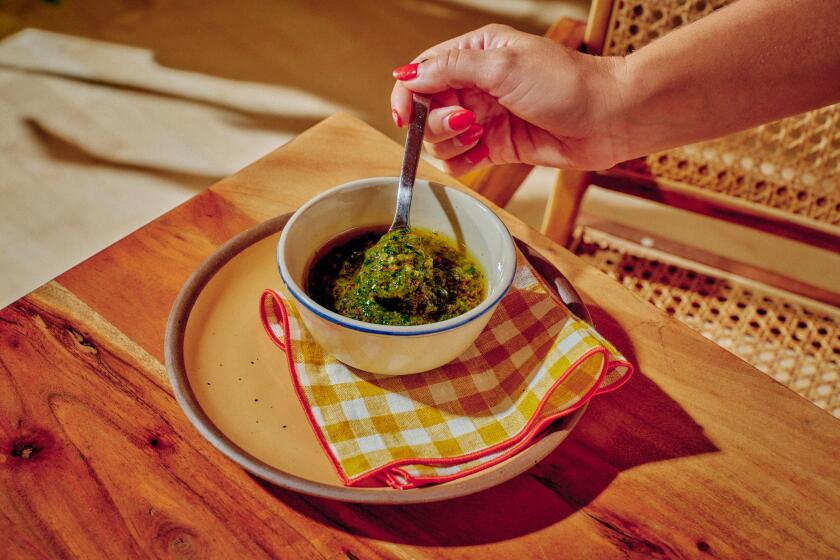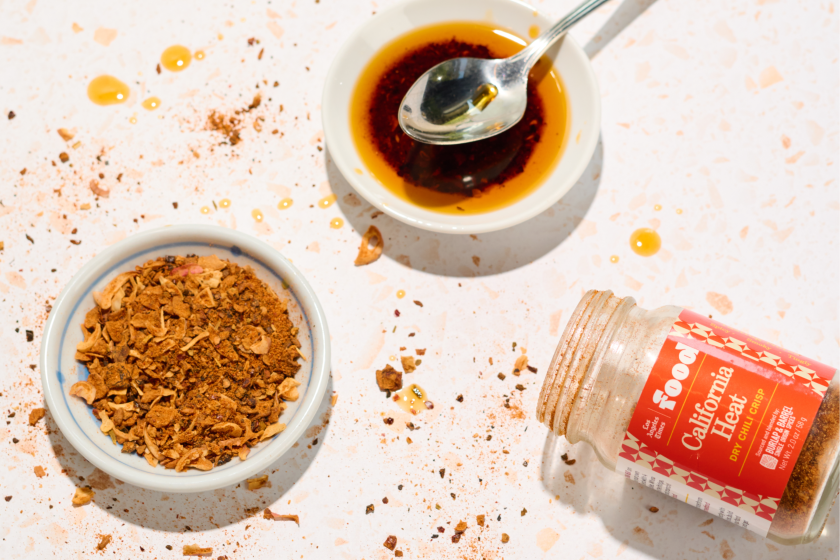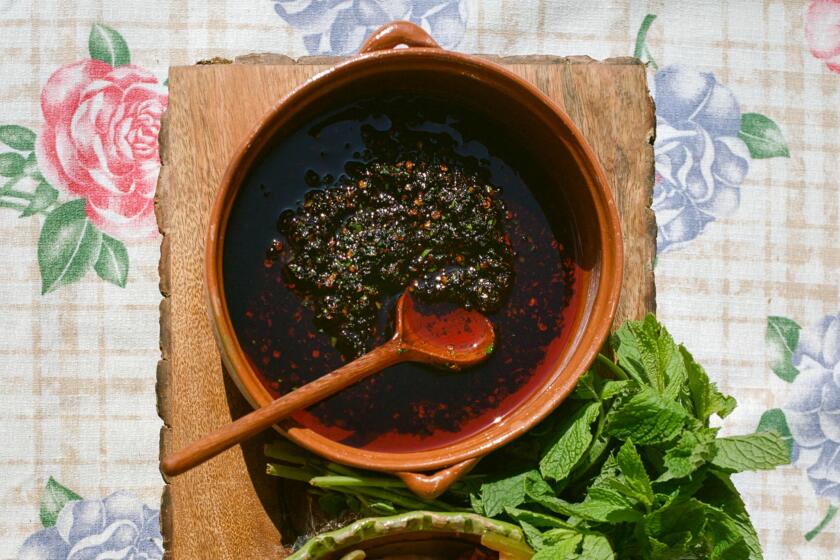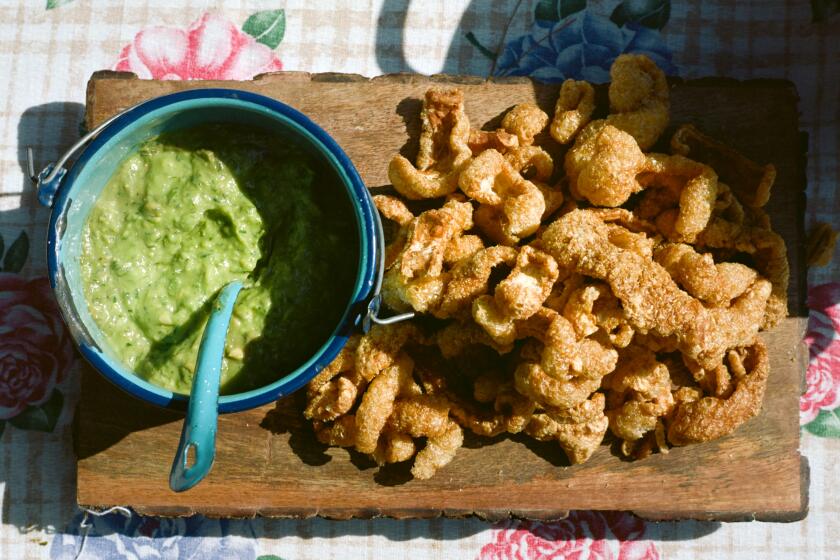Salsa verde
Once many years ago I came across a fish vendor at the farmers market with a whole tray full of beautiful fresh anchovies. On a sudden impulse, I bought them all. Real anchovies -- the ones that have been packed in salt to last -- are an essential flavoring, the garlic of the sea.
And then I repented at leisure, trying to figure out what I was going to do with them. Apparently preparing your own salted anchovies is something that had not occurred to many cookbook writers. I searched through a dozen books trying to find a method before I came to a rough description of a poor Greek fisherman preparing them in one of my favorite cookbooks, Patience Gray’s “Honey From a Weed.”
“Assisted by his children and a gallon bottle of amber wine, he pulled the heads off the fish which at the same time removed the guts, and laid the fish neatly in the petrol cans, alternating each layer with a layer of salt and finally putting a weighted board on top. In this way he provided himself and his large family with supper throughout the winter.”
Thus inspired, I spent the next couple of hours carefully pulling the heads and guts out of several pounds of 2-inch fish and arranging them neatly between layers of kosher salt. In the end, I had enough salted anchovies to last a year, but I promise you it made the $10 or so you’ll spend for a pound of the store-bought ones feel like a grand bargain.
Though there are dishes in which salted anchovies star, such as the Piedmontese anchovy-garlic dip bagna cauda, most often they’re happy to stay in the background, lending a deep savoriness that is absolutely necessary to the success of the recipe even if its source remains anonymous.
One of my favorite ways to use anchovies is in roast lamb: Stud the leg with a bouquet of anchovy, garlic and rosemary, and the flavors melt into the meat. The other night I was fixing eggplant for the grill and wondered about doing the same thing. I cut slits into thick slabs of eggplant and inserted thinly sliced garlic, a little slip of salted anchovy and a sprig of rosemary. Yowza.
Salted anchovies are also the foundation for salsa verde. Or should I say “salsas verde,” because there is no single recipe for it. Rather, it’s a varied mash of anchovies, garlic, capers and green herbs thinned with olive oil. Think of it as pesto’s rowdy cousin, coarse, big-flavored and untamed by the mellowing of cheese or nuts.
Within that broad framework of ingredients, there is much room to play. You can thicken salsa verde with soaked bread or boiled potato to make a smoother, more cosmopolitan sauce. Some recipes call for mustard or hard-cooked egg, some for cornichons or green olives. I like to add green onion and sometimes even fennel seed (amazing with grilled swordfish).
Parsley is the main herb, but it’s augmented by whatever seems good at the time. Basil, tarragon, fresh oregano, sorrel, rosemary, watercress and even nasturtiums can be used. I just found a description of salsa verde made with celery leaves, and that sounds perfect.
The sauce comes together in seconds in a blender or food processor, but I like to make it with a mortar and pestle. The pounding releases the herb’s oils, making a more fragrant mixture. And then when you taste it, there’s that wild savory tang of anchovies underneath. You can’t quite put your finger on it, but you know it’s there.
--
Tips on buying, storing and using
Maybe the hardest thing about cooking with salted anchovies is finding them in the first place. Check your local Italian deli or the deli or cheese department of a local fine grocery. You can also order them online. I get mine at Guidi Marcello in Santa Monica.
Salted anchovies are most often sold in the cans in which they come, which means massive quantities, 1 1/2 pounds or more. Though you can store them in the refrigerator in that can, I prefer to transfer them to a tightly sealed glass or plastic container. They will last months, even years stored this way. Just make sure they stay covered in salt. And this way you can spread a little anchovy love among your friends by making them little jars too.
When they come straight out of the salt, anchovies look unpromising. They take a little preparation. Rinse off any excess salt under running water and then soak the anchovies in a small bowl covered with more water. When they are flexible, after about 5 minutes, use your thumbnail to peel off the two fillets, discarding the spine, tail and any innards or finny bits that remain. Return them to soak for another 5 minutes to finish softening.
Rinse the anchovies under running water to remove excess salt and then soak in water to cover in small bowl until softened, about 5 minutes. Remove the fillets, discard the skeletons and soak another 5 minutes until flexible. Chop coarsely.
With a mortar and pestle, pound the garlic with the salt to a smooth paste. Add the capers and chopped anchovy, and pound to a coarse paste. Add the herbs and pound to a paste. Starting with just a little at a time, add the olive oil, stirring with the pestle to make a smooth emulsion. Stir in the red wine vinegar. Taste and adjust salt and vinegar.
To make salsa verde in the blender or food processor, pulse the anchovies, garlic, capers and herbs to a coarse paste. With the machine running, slowly stream in the olive oil. Stir in the vinegar and add salt to taste.
Get our Cooking newsletter.
Your roundup of inspiring recipes and kitchen tricks.
You may occasionally receive promotional content from the Los Angeles Times.











